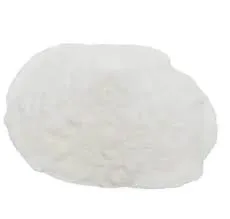
Jul . 27, 2024 11:02 Back to list
Exploring the Behavior of HPMC at the Glass Transition Temperature for Enhanced Material Properties
Understanding the Glass Transition Temperature in HPMC
Hydroxypropyl methylcellulose (HPMC) is a widely used polymer in various industries, including pharmaceuticals, food, and construction. One of the critical thermal properties of HPMC is its glass transition temperature (Tg). Understanding Tg is essential for optimizing the performance of HPMC in its applications.
What is Glass Transition Temperature (Tg)?
The glass transition temperature is the temperature range at which a polymer transitions from a brittle, glassy state to a more flexible, rubbery state. This transition is not a sharp change but rather a range of temperatures over which the material's properties gradually change. For HPMC, Tg is particularly significant as it directly influences the polymer's mechanical properties, solubility, and stability.
Factors Affecting Tg in HPMC
Several factors influence the glass transition temperature of HPMC. These include the degree of substitution, molecular weight, and the presence of additives. The degree of substitution refers to the extent to which the hydroxyl groups in cellulose are replaced with hydroxypropyl and methyl groups. Higher degrees of substitution typically lead to a lower Tg, as the added functional groups increase the flexibility of the polymer chains.
Molecular weight is another crucial factor; as the molecular weight of HPMC increases, Tg tends to increase. This is because higher molecular weight polymers have longer chains that are entangled, leading to a more rigid structure. Additionally, the presence of plasticizers, such as glycerin or polyethylene glycol, can significantly lower the Tg of HPMC by increasing chain mobility.
hpmc glass transition temperature

Significance of Tg in Applications
The glass transition temperature is a vital consideration when formulating HPMC-based products. In pharmaceutical applications, the Tg can impact the drug release profile from HPMC-based matrices. For example, if the Tg is too high, the polymer may become too rigid at body temperature, leading to a slower drug release rate. Conversely, if Tg is too low, the polymer might become too flexible, compromising the structural integrity of the drug delivery system.
In the food industry, HPMC is often used as a thickening agent, emulsifier, or film-forming agent. Understanding the Tg helps food scientists ensure that HPMC retains its desired properties under varying temperature conditions. For instance, during processing and storage, keeping HPMC below its Tg can maintain its mechanical strength and prevent it from becoming too soft or sticky.
In construction, HPMC serves as an essential additive for improving the workability and performance of cement-based materials. The Tg is vital for predicting the behavior of HPMC in dry and wet conditions and ensuring that construction materials remain durable over time.
Conclusion
In summary, the glass transition temperature of hydroxypropyl methylcellulose is a crucial property that affects its suitability for various applications. By understanding the factors that influence Tg, such as the degree of substitution, molecular weight, and the presence of additives, manufacturers can tailor HPMC formulations to meet specific performance criteria. Whether in pharmaceuticals, food, or construction, having a deep understanding of Tg enables the development of more effective and reliable products. As research continues in this area, we can expect advancements that enhance the versatility and functionality of HPMC across different industries.
-
Versatile Hpmc Uses in Different Industries
NewsJun.19,2025
-
Redispersible Powder's Role in Enhancing Durability of Construction Products
NewsJun.19,2025
-
Hydroxyethyl Cellulose Applications Driving Green Industrial Processes
NewsJun.19,2025
-
Exploring Different Redispersible Polymer Powder
NewsJun.19,2025
-
Choosing the Right Mortar Bonding Agent
NewsJun.19,2025
-
Applications and Significance of China Hpmc in Modern Industries
NewsJun.19,2025







